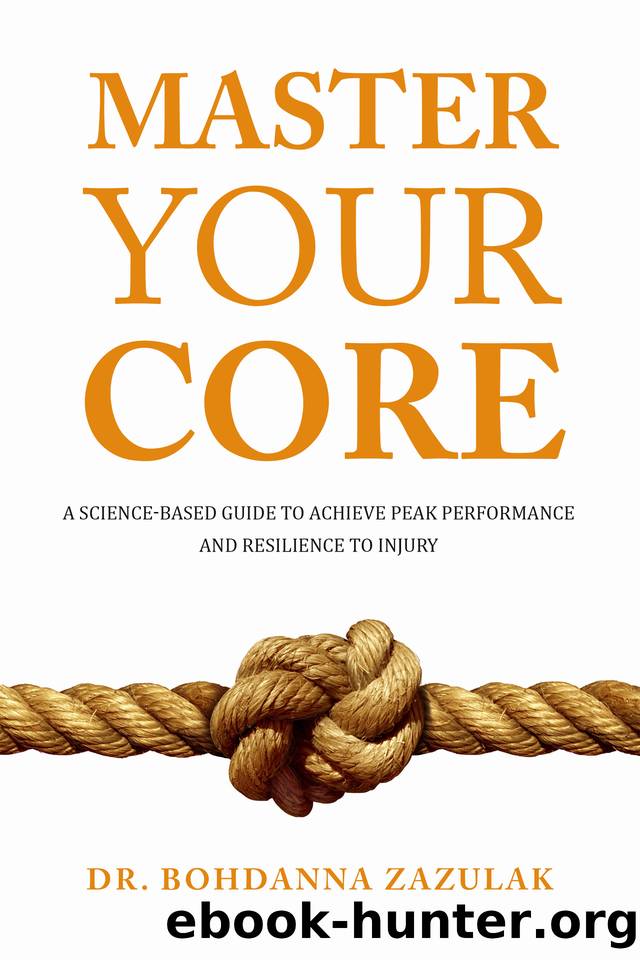Master Your Core: A Science-Based Guide to Achieve Peak Performance and Resilience to Injury by Zazulak Bohdanna

Author:Zazulak, Bohdanna
Language: eng
Format: epub
Published: 2021-06-26T16:00:00+00:00
Chapter 9
Breathing
âThe mind is the king of the senses, but the breath is the king
of the mind.â
âSvatmarama
Letâs start your path to core empowerment by learning to breathe deeply and connect your mind with your core. As James Joyce wrote, âThere is no past, no future; everything flows in an eternal present.â If you donât make self-care a priority in your life, you will pay a very high price as your health declines. Take time every day to fully experience the present moment, awaken your senses, and establish effective and efficient mindful breathing strategies for optimal core activation.
Deep breathing, in combination with the targeted trunk-stretching exercises youâll learn in this chapter, will help you deepen your mind-core connection. This is the critical first step to improving your core health. As you do these exercises, pay special attention to your breathing and the sensations in your body as you move. Putting your focus and awareness on your muscles and body is a key step in improving proprioception and core awareness. Do not rush through these exercises just to âcheck them off your list.â You will get the best results by taking your time and focusing on every step of the process. Experience what it feels like as your muscles engage and move throughout every part of these exercises. Breath training will increase the recruitment of core musculature, improve functional biomechanics, and create new neural connections throughout your brain and body, all of which will protect and empower you.
Breathing Mechanics
âFor breath is life, so if you breathe well you will live long on earth.â
âSanskrit Proverb
Scientific evidence shows us that developing breathing mechanics in coordination with the core musculature (including abdominal and back musculature, as well as the inner core muscles) is important for postural control, core stability, and optimal wellness. Muscles that play important roles in core stability include the diaphragm (the dome-shaped muscles at the base of the lungs) as the superior boundary of the core, the pelvic floor (the muscular sling at the base of your abdomen) as the inferior boundary, the multifidus (which stabilizes the spinal column), and the transverse abdominis (the circumferential boundary) (). These muscular boundaries of your trunk work together in unison to produce a corset-like stabilization effect for your core. It is the goal of core stability exercises to activate these respiratory and postural muscles in a coordinated manner, and to maximize 360 degrees of control for complex daily maneuvers and athletic activities.
Download
This site does not store any files on its server. We only index and link to content provided by other sites. Please contact the content providers to delete copyright contents if any and email us, we'll remove relevant links or contents immediately.
Tools of Titans by Timothy Ferriss(7861)
Bodyweight Strength Training by Jay Cardiello(7688)
Born to Run: by Christopher McDougall(6919)
Inner Engineering: A Yogi's Guide to Joy by Sadhguru(6473)
Asking the Right Questions: A Guide to Critical Thinking by M. Neil Browne & Stuart M. Keeley(5394)
The Fat Loss Plan by Joe Wicks(4644)
Bodyweight Strength Training Anatomy by Bret Contreras(4494)
Yoga Anatomy by Kaminoff Leslie(4118)
Science and Development of Muscle Hypertrophy by Brad Schoenfeld(3979)
Dynamic Alignment Through Imagery by Eric Franklin(3941)
ACSM's Complete Guide to Fitness & Health by ACSM(3837)
The Four-Pack Revolution by Chael Sonnen & Ryan Parsons(3809)
Exercise Technique Manual for Resistance Training by National Strength & Conditioning Association(3803)
Bodyweight Strength Training: 12 Weeks to Build Muscle and Burn Fat by Jay Cardiello(3793)
Yoga Anatomy by Leslie Kaminoff & Amy Matthews(3755)
The Ultimate Bodybuilding Cookbook by Kendall Lou Schmidt(3728)
Yoga Therapy by Mark Stephens(3579)
Nutrition for Sport, Exercise, and Health by Spano Marie & Kruskall Laura & Thomas D. Travis(3568)
Nutrition for Sport, Exercise, and Health by Marie Spano & Laura Kruskall & D. Travis Thomas(3563)
